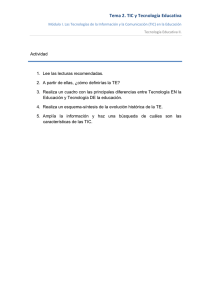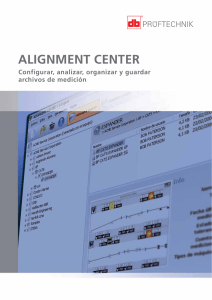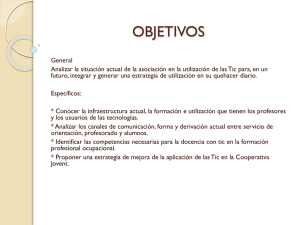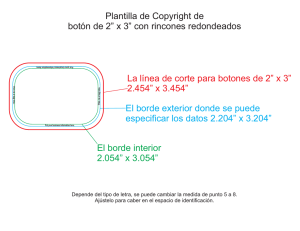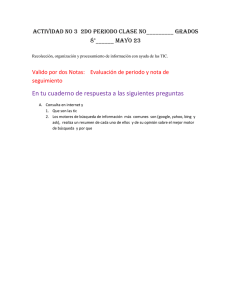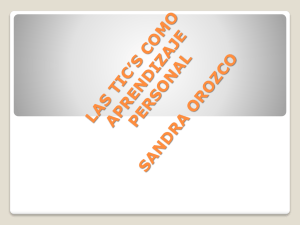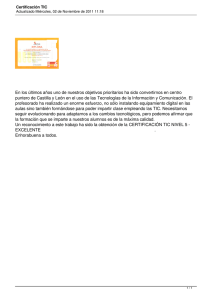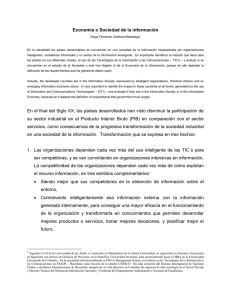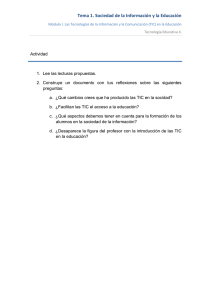MODELOS PARA LA ALINEACIÓN ESTRATÉGICA ENTRE EL
Anuncio
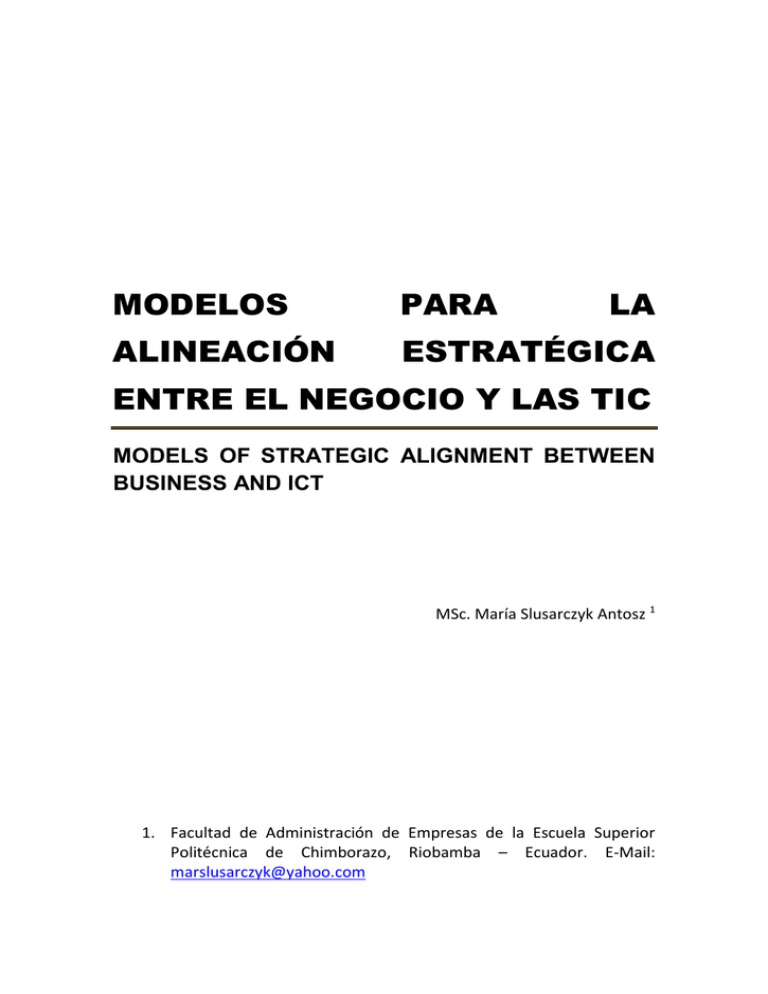
MODELOS PARA LA ALINEACIÓN ESTRATÉGICA ENTRE EL NEGOCIO Y LAS TIC MODELS OF STRATEGIC ALIGNMENT BETWEEN BUSINESS AND ICT MSc. María Slusarczyk Antosz 1 1. Facultad de Administración de Empresas de la Escuela Superior Politécnica de Chimborazo, Riobamba – Ecuador. E-Mail: marslusarczyk@yahoo.com RESUMEN Alineamiento estratégico es una importante táctica para conseguir el valor de negocio a través de las inversiones en TIC. En este trabajo se presenta diferentes modelos de alineación estratégica entre las TIC y los objetivos de negocios como también los temas relacionados con la arquitectura empresarial. Se analiza la organización de las TIC tanto a nivel corporativo como a nivel interno. Entre los modelos de alineamiento entre las TIC y las estrategias del negocio se considera: modelo SAM, modelo de Luftman, TOGAF, modelo basado en los resultados y otros. Se concluye que los modelos juegan un papel muy importante dentro del objetivo de alineamiento estratégico de las TIC con las metas del negocio. Para la empresa crean el valor no solamente las herramientas informáticas que se seleccionan, sino también la forma en que estas se utilizan en la organización. ABSTRACT Strategic alignment is an important tactic to get business value through ICT investments. In this work enterprise architecture and different models of strategic alignment between ICT and business objectives is presented. ICT organization is analyzed at corporate and internal level. Among the models of alignment between ICT and business strategies are considered: SAM model, Luftman model, TOGAF, performance-based model and others. It is concluded that models play an important role within the scope of strategic alignment of ICT with business goals. For the company create value not only the tools that are selected, but also the way these are used in the organization. PALABRAS CLAVE Alineación estratégica; TIC; modelo centralizado; modelo de Luftman; arquitectura empresarial KEY WORDS Strategic alignment; ICT; centralized model; Luftman model; enterprise architecture REFERENCIAS BIBLIOGRÁFICAS Broadbent, M., & Weill, P. (1998). Leveraging the new infrastructure - How market leaders capitalize on Information Technology. Harvard Business School Press. Burn, J.M., & Szeto, C. (2000). A comparison of the views of business and IT management on success factors for strategic alignment. Information &Management, 37. Drucker, Peter F. (1964). Managing for results: economic tasks and risktaking decisions. New York: Routledge, ISBN-13: 978-0750643917 Duffy, J. (2002). IT/Business alignment: Is it an option or is it mandatory? IDC document # 26831. Estrategia TIC 2011-2015, la hoja de ruta de la Generalitat Valenciana en TIC. (2011). Obtenido de: http://www.dgti.gva.es/documents/85347/355059/estrategia_tic_20 11-2015.pdf/7f9edffa-76b8-4dcb-b999-db57ae3a6aa4 Guldentops, E. (2003). Governing Information Technology through CobiT. In W. Van Grembergen (Ed.), Strategies for Information Technology Governance. Hershey, PA: Idea Group Publishing. Henderson, Bruce (1 January 1981). "The Concept of Strategy". Boston Consulting Group. Retrieved 28 de octubre 2015. Henderson, J.C., & Venkatraman, N. (1993). Strategic alignment: Leveraging Information Technology for transforming organizations. IBM Systems Journal, 32(1). Henderson, J.C.,Venkatraman, N., & Oldach, S. (1993). Continuous strategic alignment. Exploiting Information Technology Capabilities for Competitive Success. European Management Journal, 11(2), Business Quarterly, 55(3). Importancia de las TIC para la gestión empresarial, 27 de agosto de 2013, http://www.aniel.es/importancia-de-las-tic-para-la-gestionempresarial/ ITGI (2000). CobiT: Governance, Control and Audit for Information and Related Technology. Available online: www.itgi.org. ITGI (2002). IT Governance executive summary. Available online: www.itgi.org. ITGI (2002). IT Strategy committee. Available online: www.itgi.org. Leonard, Jenny: What are we aligning? Implications of a Dynamic Approach to Alignment, 19th Australian Conference on Information Systems, Christchurch, 2008 Luftman, J. (2000). Assessing Communications of AIS, 4. Business-IT alignment maturity. Luftman, J., & Brier, T. (1999). Achieving and sustaining business-IT alignment. California Management Review, 42(1), 109–122. Molano, A. (2015). ¿Qué es arquitectura empresarial? Obtenido de: http://www.colombiadigital.net/actualidad/articulosinformativos/item/8123-que-es-arquitectura-empresarial.html Molina, D. (11 de 2014). Nuevo modelo de gobernanza de las TIC. boletic 71. Obtenido de: http://www.astic.es/sites/default/files/articulosboletic/mono6_doming_m olina.pdf Monreal, Gabriel. (2014). http://gmonreal.blogspot.com/ La Arquitectura Empresarial. Pachory, Ashish. (2013). Business IT Alignment - Beyond the Platitudes. Obtenido de: http://cfoconnect.com/title_detail.asp?art_id=1367&cat_id=6, Sessions, Roger. (2010). The IT Complexity Crisis: Danger and Opportunity. Strassmann, Paul. August 1998, The Squandered Computer, The Information Economics Press, 1997, Smaczny, T. (2001). Is an alignment between business and Information Technology the appropriate paradigm to manage IT in today's organizations? Management Decisions, 39(10). Uribe, Luis. (2013). Alineación de la estrategia de TIC con la estrategia empresarial: un modelo. Trabajo de grado de Magister en Administración. Van Der Zee, J.T.M., & De Jong, B. (1999). Alignment is not enough: Integrating business and Information Technology management with the balanced business scorecard. Journal of Management Information Systems, 16(2). Winkler, T. (2014). Information Management and IT Strategy. La Habana. Zachman, John. (1987). A Framework for Information Systems Architecture. In: IBM Systems Journal, vol. 26, no. 3, 1987. IBM Publication G3215298.
